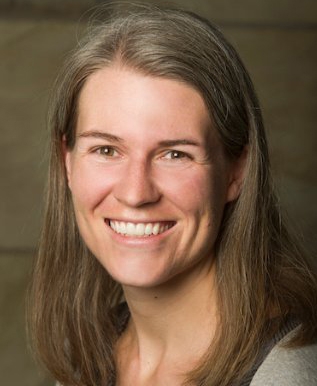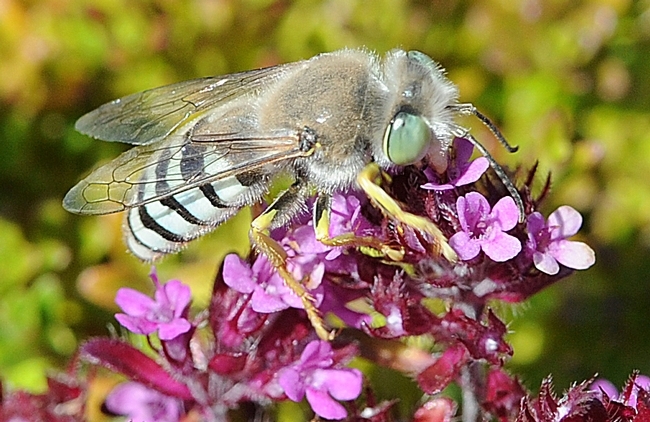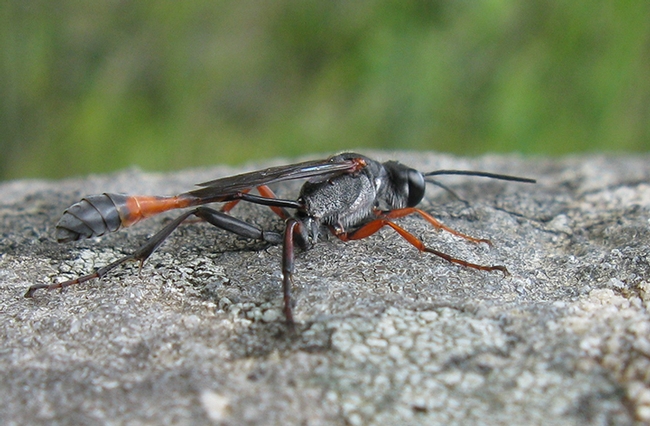- Author: Kathy Keatley Garvey

Every year the UC Davis Insect Ecology group lists its favorite papers, said community ecologist Rachel Vannette of the UC Davis Department of Entomology and Nematology. She listed the group's favorites on her lab website and also listed her lab's picks.
Menke, who received his doctorate in entomology from UC Davis in 1965, studying with Professor Richard Bohart (for whom the Bohart Museum of Entomology is named), is a noted expert on wasps. Ammophila are sometimes called "thread-waisted wasps" or "sand wasps" but neither is definitive. Ammophila comes from the Greek "sand lover." (See BugGuide.net for images.)
A partial abstract of the Menke publication:
"The North and Central American species of Ammophila are described and a key provided for their identification. Sixty-nine species are recognized, of which 62 are known from North America. The other seven are known only from Mexico. Four new species are described, hallelujah from northeastern California, linda from southern California, mexica and zapoteca from south central Mexico."
Menke is also the co-author of "Funny or Curious Zoological Names." Included in the list: he named a species of Australian wasp, "Aha ha," as a joke. From Wikipedia: "Menke described several years after its discovery how, when he received a package from a colleague containing insect specimens, he exclaimed 'Aha, a new genus,' with fellow entomologist Eric Grissell responding "ha" doubtfully. The name of the insect is commonly found in lists of bizarre scientific names. The name was also used as the vehicle registration plate of Menke's car, "AHA HA."
The UC Davis Insect Ecology list:
- Lonsdorf, E.V., Koh, I. and Ricketts, T., 2020. Partitioning private and external benefits of crop pollination services. People and Nature, 2(3), pp.811-820. https://bit.ly/2XGUrLm
- Nichols, Bethany S., Gerhard Leubner?Metzger, and Vincent AA Jansen. “Between a rock and a hard place: adaptive sensing and site?specific dispersal.” Ecology Letters 23.9 (2020): 1370-1379.? ?https://bit.ly/39r1sVK
- Eberl, F., Fernandez de Bobadilla, M., Reichelt, M., Hammerbacher, A., Gershenzon, J. and Unsicker, S.B. (2020), Herbivory meets fungivory: insect herbivores feed on plant pathogenic fungi for their own benefit. Ecol Lett, 23: 1073-1084. https://bit.ly/3iccPFf
- Larsen, C.D. and Hargreaves, A.L., 2020. Miniaturizing landscapes to understand species distributions. Ecography. ?https://bit.ly/2MV4olZ
- Koski, M.H., MacQueen, D. and Ashman, T.L., 2020. Floral pigmentation has responded rapidly to global change in ozone and temperature. Current Biology, 30(22), pp.4425-4431. https://bit.ly/39zfnZX
- Lundgren, E. J., Ramp, D., Rowan, J., Middleton, O., Schowanek, S. D., Sanisidro, O., … & Wallach, A. D. (2020). Introduced herbivores restore Late Pleistocene ecological functions. Proceedings of the National Academy of Sciences, 117(14), 7871-7878. https://bit.ly/3ilILHm
- Pashalidou, F.G., Lambert, H., Peybernes, T., Mescher, M.C. and De Moraes, C.M., 2020. Bumble bees damage plant leaves and accelerate flower production when pollen is scarce. Science, 368(6493), pp.881-884. ?https://bit.ly/3bGdI7O
- Losapio, G., & Schöb, C. (2020). Pollination interactions reveal direct costs and indirect benefits of plant–plant facilitation for ecosystem engineers. Journal of Plant Ecology, 13(1), 107-113.? https://bit.ly/2XJ3v22
- LeCroy, K.A., Savoy-Burke, G., Carr, D.E., Delaney, D.A. and T'ai, H.R., 2020. Decline of six native mason bee species following the arrival of an exotic congener. Scientific Reports, 10(1), pp.1-9. ?https://go.nature.com/3nJUaSq
- Milet-Pinheiro, P., Domingos-Melo, A., Olivera, J.B., Albuquerque, N.S., Costa, A.C.G., Albuquerque-Lima, S., Silva, M.F., Navarro, D.M., Maia, A.C., Gundersen, L.L. and Schubert, M., 2020. A Semivolatile Floral Scent Marks the Shift to a Novel Pollination System in Bromeliads. Current Biology. ?https://bit.ly/3ihb6yy
- Adams, J.V. and Jones, M.L., 2020. Evidence of host switching: Sea lampreys disproportionately attack Chinook salmon when lake trout abundance is low in Lake Ontario. Journal of Great Lakes Research. ?https://bit.ly/3syTQcT
- Twardochleb, L.A., Treakle, T.C. and Zarnetske, P.L., 2020. Foraging strategy mediates ectotherm predator–prey responses to climate warming. Ecology, 101(11), p.e03146. ?https://bit.ly/3sqZtJR
- Menke, A. S. 2020. The Ammophila of North & Central America (Hymenoptera, Sphecidae). (No link available. This can ordered from the Bohart Museum of Entomology)
- Luttbeg et al. 2020 Safety cues give prey more valuable information than danger cues. Am Nat. 195:636-648? https://bit.ly/2LO3A1Y
- Mathis, K.A. and Bronstein, J.L., 2020. Our Current Understanding of Commensalism. Annual Review of Ecology, Evolution, and Systematics, 51, pp.167-189. ?https://bit.ly/3nG7zuJ
- Simmonds, E. G., E. F. Cole, B. C. Sheldon, and T. Coulson. 2020. Phenological asynchrony: a ticking time-bomb for seemingly stable populations? Ecology Letters 23:1766–1775. https://bit.ly/35I6oVd

- Trunz, V., Lucchetti, M. A., Bénon, D., Dorchin, A., Desurmont, G. A., Kast, C., … & Praz, C. J. (2020). To bee or not to bee: The ‘raison d'être'of toxic secondary compounds in the pollen of Boraginaceae. Functional Ecology, 34(7), 1345-1357. https://bit.ly/2XG0lMz
- Malone, S.C., Weaver, D.K., Seipel, T.F. et al. Herbivore-induced volatile emissions are altered by soil legacy effects in cereal cropping systems. Plant Soil 455, 171–186 (2020). https://bit.ly/3icfYVz
- Derek W Dunn, Stability in fig tree–fig wasp mutualisms: how to be a cooperative fig wasp, Biological Journal of the Linnean Society, Volume 130, Issue 1, May 2020, Pages 1–17, https://bit.ly/2LLjbzb
- Goelen, T., Sobhy, I. S., Vanderaa, C., Wäckers, F., Rediers, H., Wenseleers, T., et al. 2020. Bacterial phylogeny predicts volatile organic compound composition and olfactory response of an aphid parasitoid. Oikos. https://bit.ly/2N25TPn
- Imachi H, Nobu MK, Nakahara N, Morono Y, Ogawara M, Takaki Y, et al. Isolation of an archaeon at the prokaryote–eukaryote interface. Nature. 2020 Jan 23;577(7791):519–25. Available from: https://bit.ly/2XFDzV1
- Prado A, Marolleau B, Vaissière BE, Barret M, Torres-Cortes G. Insect pollination: an ecological process involved in the assembly of the seed microbiota. Sci Rep. 2020;10(1):1–11. https://bit.ly/3oNj9W5
- Pashalidou, F.G., Lambert, H., Peybernes, T., Mescher, M.C. and De Moraes, C.M., 2020. Bumble bees damage plant leaves and accelerate flower production when pollen is scarce. Science, 368(6493), pp.881-884. ?https://bit.ly/2KfKnFP
- Pozo, M. I., , , , , , , and . 2020. The impact of yeast presence in nectar on bumble bee behavior and fitness. Ecological Monographs 90( 1):e01393. 10.1002/ecm.1393




